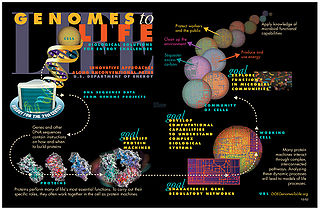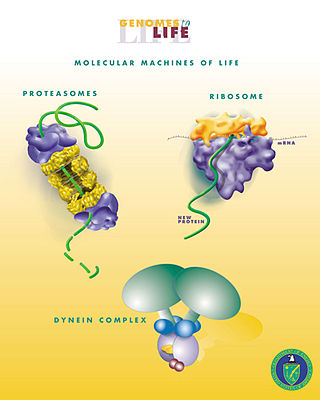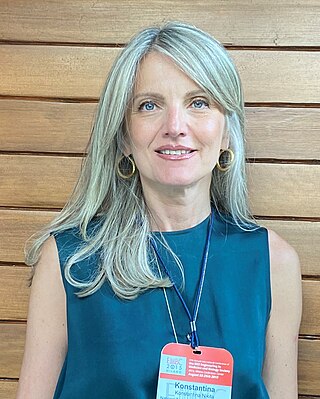Related Research Articles
Systems theory is the transdisciplinary study of systems, i.e. cohesive groups of interrelated, interdependent components that can be natural or artificial. Every system has causal boundaries, is influenced by its context, defined by its structure, function and role, and expressed through its relations with other systems. A system is "more than the sum of its parts" by expressing synergy or emergent behavior.

Computational biology refers to the use of data analysis, mathematical modeling and computational simulations to understand biological systems and relationships. An intersection of computer science, biology, and big data, the field also has foundations in applied mathematics, chemistry, and genetics. It differs from biological computing, a subfield of computer science and engineering which uses bioengineering to build computers.

Biopsychosocial models are a class of trans-disciplinary models which look at the interconnection between biology, psychology, and socio-environmental factors. These models specifically examine how these aspects play a role in topics ranging from human development to health and disease.

The following outline is provided as an overview of and topical guide to academic disciplines:
Computational neuroscience is a branch of neuroscience which employs mathematics, computer science, theoretical analysis and abstractions of the brain to understand the principles that govern the development, structure, physiology and cognitive abilities of the nervous system.

Systems biology is the computational and mathematical analysis and modeling of complex biological systems. It is a biology-based interdisciplinary field of study that focuses on complex interactions within biological systems, using a holistic approach to biological research.
Mathematical and theoretical biology, or biomathematics, is a branch of biology which employs theoretical analysis, mathematical models and abstractions of the living organisms to investigate the principles that govern the structure, development and behavior of the systems, as opposed to experimental biology which deals with the conduction of experiments to prove and validate the scientific theories. The field is sometimes called mathematical biology or biomathematics to stress the mathematical side, or theoretical biology to stress the biological side. Theoretical biology focuses more on the development of theoretical principles for biology while mathematical biology focuses on the use of mathematical tools to study biological systems, even though the two terms are sometimes interchanged.
Biorobotics is an interdisciplinary science that combines the fields of biomedical engineering, cybernetics, and robotics to develop new technologies that integrate biology with mechanical systems to develop more efficient communication, alter genetic information, and create machines that imitate biological systems.
The philosophy of biology is a subfield of philosophy of science, which deals with epistemological, metaphysical, and ethical issues in the biological and biomedical sciences. Although philosophers of science and philosophers generally have long been interested in biology, philosophy of biology only emerged as an independent field of philosophy in the 1960s and 1970s, associated with the research of David Hull. Philosophers of science then began paying increasing attention to biology, from the rise of Neodarwinism in the 1930s and 1940s to the discovery of the structure of DNA in 1953 to more recent advances in genetic engineering. Other key ideas include the reduction of all life processes to biochemical reactions, and the incorporation of psychology into a broader neuroscience.
Biomedical cybernetics investigates signal processing, decision making and control structures in living organisms. Applications of this research field are in biology, ecology and health sciences.

A neural network is a neural circuit of biological neurons, sometimes also called a biological neural network, or a network of artificial neurons or nodes in the case of an artificial neural network.
Biocybernetics is the application of cybernetics to biological science disciplines such as neurology and multicellular systems. Biocybernetics plays a major role in systems biology, seeking to integrate different levels of information to understand how biological systems function. The field of cybernetics itself has origins in biological disciplines such as neurophysiology. Biocybernetics is an abstract science and is a fundamental part of theoretical biology, based upon the principles of systemics. Biocybernetics is a psychological study that aims to understand how the human body functions as a biological system and performs complex mental functions like thought processing, motion, and maintaining homeostasis.(PsychologyDictionary.org)Within this field, many distinct qualities allow for different distinctions within the cybernetic groups such as humans and insects such as beehives and ants. Humans work together but they also have individual thoughts that allow them to act on their own, while worker bees follow the commands of the queen bee. . Although humans often work together, they can also separate from the group and think for themselves.(Gackenbach, J. 2007) A unique example of this within the human sector of biocybernetics would be in society during the colonization period, when Great Britain established their colonies in North America and Australia. Many of the traits and qualities of the mother country were inherited by the colonies, as well as niche qualities that were unique to them based on their areas like language and personality—similar vines and grasses, where the parent plant produces offshoots, spreading from the core. Once the shoots grow their roots and get separated from the mother plant, they will survive independently and be considered their plant. Society is more closely related to plants than to animals since, like plants, there is no distinct separation between parent and offspring. The branching of society is more similar to plant reproduction than to animal reproduction. Humans are a k- selected species that typically have fewer offspring that they nurture for longer periods than r -selected species. It could be argued that when Britain created colonies in regions like North America and Australia, these colonies, once they became independent, should be seen as offspring of British society. Like all children, the colonies inherited many characteristics, such as language, customs and technologies, from their parents, but still developed their own personality. This form of reproduction is most similar to the type of vegetative reproduction used by many plants, such as vines and grasses, where the parent plant produces offshoots, spreading ever further from the core. When such a shoot, once it has produced its own roots, gets separated from the mother plant, it will survive independently and define a new plant. Thus, the growth of society is more like that of plants than like that of the higher animals that we are most familiar with, there is not a clear distinction between a parent and its offspring. Superorganisms are also capable of the so-called "distributed intelligence," a system composed of individual agents with limited intelligence and information. These can pool resources to complete goals beyond the individuals' reach on their own. Similar to the concept of "Game theory." In this concept, individuals and organisms make choices based on the behaviors of the other player to deem the most profitable outcome for them as an individual rather than a group.

Biological engineering or bioengineering is the application of principles of biology and the tools of engineering to create usable, tangible, economically viable products. Biological engineering employs knowledge and expertise from a number of pure and applied sciences, such as mass and heat transfer, kinetics, biocatalysts, biomechanics, bioinformatics, separation and purification processes, bioreactor design, surface science, fluid mechanics, thermodynamics, and polymer science. It is used in the design of medical devices, diagnostic equipment, biocompatible materials, renewable energy, ecological engineering, agricultural engineering, process engineering and catalysis, and other areas that improve the living standards of societies.
Translational bioinformatics (TBI) is a field that emerged in the 2010s to study health informatics, focused on the convergence of molecular bioinformatics, biostatistics, statistical genetics and clinical informatics. Its focus is on applying informatics methodology to the increasing amount of biomedical and genomic data to formulate knowledge and medical tools, which can be utilized by scientists, clinicians, and patients. Furthermore, it involves applying biomedical research to improve human health through the use of computer-based information system. TBI employs data mining and analyzing biomedical informatics in order to generate clinical knowledge for application. Clinical knowledge includes finding similarities in patient populations, interpreting biological information to suggest therapy treatments and predict health outcomes.
Systems medicine is an interdisciplinary field of study that looks at the systems of the human body as part of an integrated whole, incorporating biochemical, physiological, and environment interactions. Systems medicine draws on systems science and systems biology, and considers complex interactions within the human body in light of a patient's genomics, behavior and environment.

Marcello Barbieri is an Italian theoretical biologist at the University of Ferrara whose main interest is the origin of novelties in macroevolution. He has been one of founders and first editor-in-chief of the journal Biosemiotics until 2012; currently, he is an editor of the journal BioSystems. His research field is code biology, the study of all codes of life from the genetic code to the codes of culture. His major books are The Semantic Theory of Evolution (1985), The Organic Codes (2003), and Code Biology. A New Science of Life (2015).
Felix Tretter is an Austrian psychologist and psychiatrist. From 1992 to 2014 he was head of the addiction department of the Isar-Amper-Klinikum München-Ost, formerly known as Bezirkskrankenhaus Haar, Bavaria, Germany. His scientific work has emphasis on modelling of psychophysical scenarios in schizophrenia and addiction research with methods of systems science.

Konstantina "Nantia" Nikita is a Greek electrical and computer engineer and a professor at the School of Electrical and Computer Engineering at the National Technical University of Athens (NTUA), Greece. She is director of the Mobile Radiocommunications Lab and founder and director of the Biomedical Simulations and Imaging Lab, NTUA. Since 2015, she has been an Irene McCulloch Distinguished Adjunct Professor of Biomedical Engineering and Medicine at Keck School of Medicine and Viterbi School of Engineering, University of Southern California.

Biological data refers to a compound or information derived from living organisms and their products. A medicinal compound made from living organisms, such as a serum or a vaccine, could be characterized as biological data. Biological data is highly complex when compared with other forms of data. There are many forms of biological data, including text, sequence data, protein structure, genomic data and amino acids, and links among others.
References
- ↑ Brian H. Rudall (2000). "Cybernetics and systems in the 1980s". In: Kybernetes. Vol 29. Issue 5/6 p.595-611.
- 1 2 3 4 5 J.W. Dietrich (2004), Medical Cybernetics – A Definition, Medizinische Kybernetik, 2004. Released under creative commons 2.0 attribution licence.
- ↑ Tretter, F; Wolkenhauer, O; Meyer-Hermann, M; Dietrich, JW; Green, S; Marcum, J; Weckwerth, W (2021). "The Quest for System-Theoretical Medicine in the COVID-19 Era". Frontiers in Medicine. 8: 640974. doi: 10.3389/fmed.2021.640974 . PMC 8039135 . PMID 33855036.
- ↑ Tsukamoto, Y (21 June 1979). "An information theory of the genetic code". Journal of Theoretical Biology. 78 (4): 451–98. doi:10.1016/0022-5193(79)90187-5. PMID 513794.
- ↑ Figureau, A (1987). "Information theory and the genetic code". Origins of Life and Evolution of Biospheres. 17 (3–4): 439–49. doi:10.1007/BF02386481. PMID 3627775. S2CID 25129093.
- ↑ Battail, Gérard (2007). "Information Theory and Error-Correcting Codes In Genetics and Biological Evolution". Introduction to Biosemiotics: 299–345. doi:10.1007/1-4020-4814-9_13. ISBN 978-1-4020-4813-5.
- ↑ Kuruoglu, EE; Arndt, PF (21 April 2017). "The information capacity of the genetic code: Is the natural code optimal?". Journal of Theoretical Biology. 419: 227–237. doi:10.1016/j.jtbi.2017.01.046. hdl: 21.11116/0000-0000-7D7E-8 . PMID 28163008.
- ↑ Ramakrishnan, Nithya; Bose, R. (20 August 2012). "Dipole entropy based techniques for segmentation of introns and exons in DNA". Applied Physics Letters. 101 (8): 083701. doi:10.1063/1.4747205.